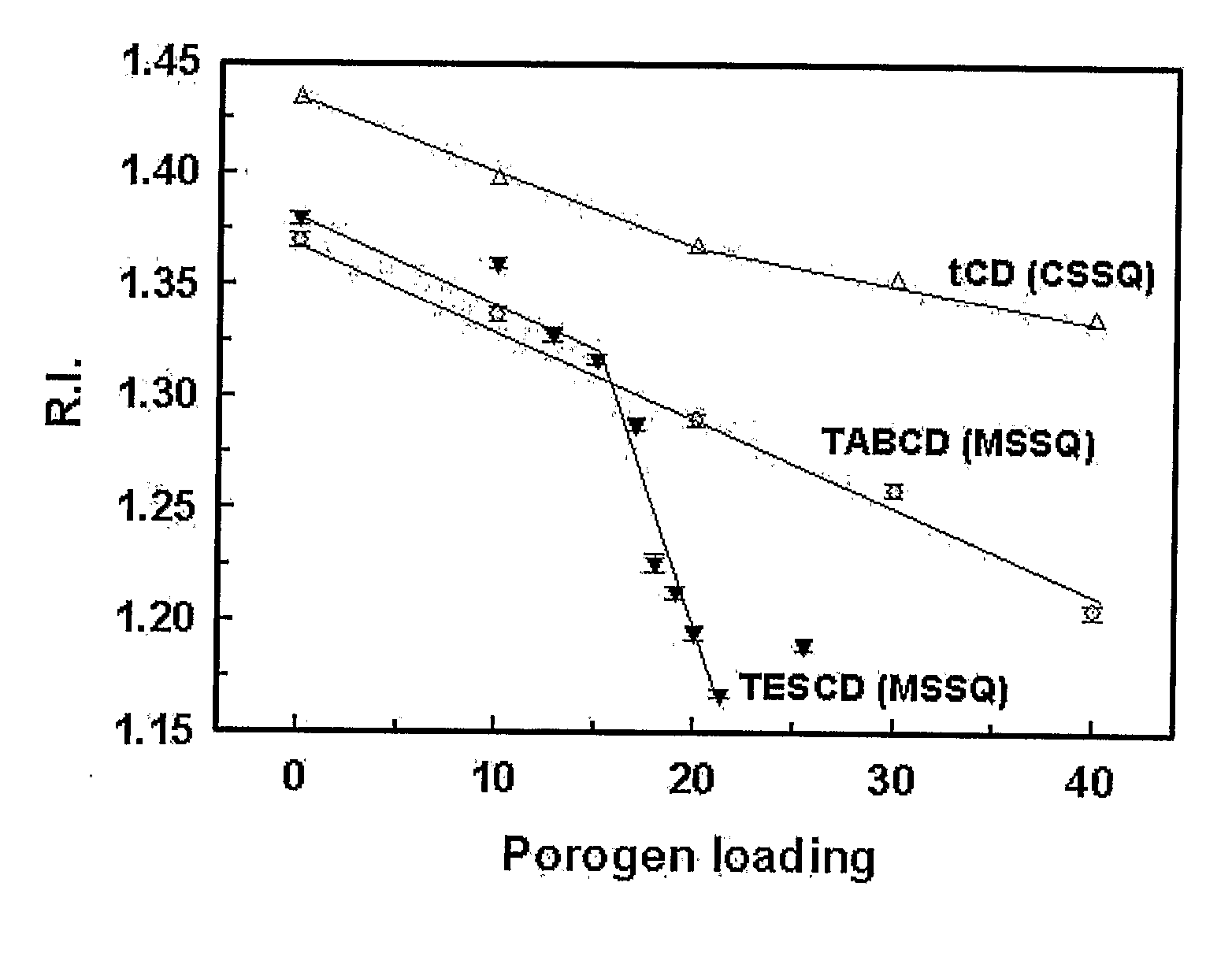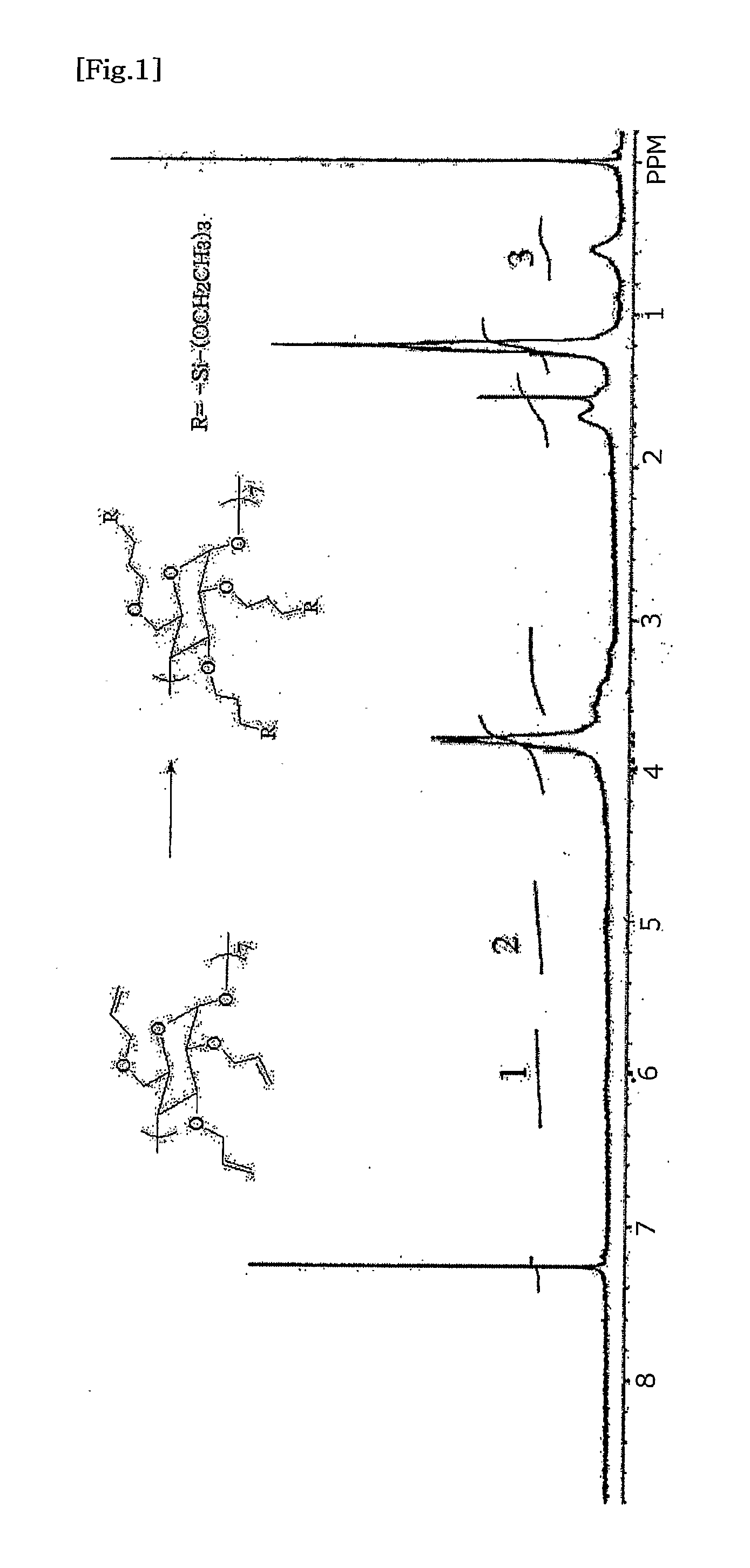Reactive cyclodextrin derivatives as pore-forming templates, and low dielectric materials prepared by using the same
a technology of cyclodextrin and pore-forming templates, which is applied in the direction of cellulose substances, solid-state devices, electrical devices, etc., can solve the problems of signal delay, increase in pore size and its distribution, and serious problem in the mechanical strength of the matrix and process reliability
- Summary
- Abstract
- Description
- Claims
- Application Information
AI Technical Summary
Benefits of technology
Problems solved by technology
Method used
Image
Examples
preparation example
odextrin Containing Ethoxysilane Group
[0035] 5.24 g of cyclodextrin was dissolved in 20 mL of dimethylformamide (DMF) and then slowly added into DMF solution, where NaH is already dissolved, to induce dehydrogenation and then dropwisely added with 21 mL of allylbromide to remove the solvent and excess allylbromide to manufacture cyclodextrin which contains allyl groups.
[0036] Thus manufactured material is again dissolved in 1.8 g of triethoxysilane where platimum oxide catalyst was added to proceed a reaction and then cyclodextrin (yield 80%) containing ethoxysilane groups was finally obtained by removing the solvent and the catalyst. Furthermore, the 1H-NMR spectrum of heptakis(2,3,6-tri-O-(3-triethoxysilylpropyl)-β-cyclodextrin) (TESCD) manufactured by the above preparation method is shown in FIG. 1.
example 1
[0037] As matrix components, polymethylsilsesquioxane precursor (GR65OF™, Si—OH / Si atom ratio=9%) or polymethylsilsesquioxane copolymer were manufactured to the concentration of 20 wt. % by using n-butyl acetate. Polymethylsilsesquioxane copolymer is disclosed in Korea Patent Laid-open Application No. 2002-38540 and a copolymer wherein methyltrimethoxysilane and α,ω-bistrimethoxysilylethane are mixed in 9:1 mole ratio.
[0038] As a nanoparticular porogen, heptakis(2,3,6-tri-O-(3-triethoxysilylpropyl)-β-cyclodextrin) (TESCD) was manufactured to the concentration of 20 wt. % by using n-butyl acetate. In addition, an ultralow dielectric thin film was manufactured by changing the volume ratio of the respective matrix solution and the template solution.
[0039] More specifically, matrix component and template were respectively dissolved in n-butyl acetate and then mixed to manufacture an organic-inorganic mixed solution. Then, the mixture was passed through poly(tetrafluoroethylene) (PTFE)...
example 2
[0040] The heptakis(2,3,6-tri-O-(3-triethoxysilylpropyl)-β-cyclodextrin) (TESCD) manufactured in the above preparation example was dissolved in THF to the concentration of about 3 to 20 wt. %, dropwisely added with a small amount of water and HCl catalyst, and then sol-gel reaction was performed at 0° C. for about 2 to 4 hours. Removal of the catalyst was performed by adding excess diethyl ether and water to the reaction mixture and removing diethyl ether again and finally manufacturing silicate matrix precursor in sol state. Thus prepared silicate precursor was dissolved again in n-butyl acetate solvent to the concentration of about 10 to 50 wt. %, followed by spin coating and heat treatment, while was same as in example 1 and a silicate low dielectric membrane with excellent mechanical properties containing nanopores was finally manufactured.
PUM
| Property | Measurement | Unit |
|---|---|---|
| porosity | aaaaa | aaaaa |
| porosity | aaaaa | aaaaa |
| dielectric constant | aaaaa | aaaaa |
Abstract
Description
Claims
Application Information
 Login to View More
Login to View More - R&D
- Intellectual Property
- Life Sciences
- Materials
- Tech Scout
- Unparalleled Data Quality
- Higher Quality Content
- 60% Fewer Hallucinations
Browse by: Latest US Patents, China's latest patents, Technical Efficacy Thesaurus, Application Domain, Technology Topic, Popular Technical Reports.
© 2025 PatSnap. All rights reserved.Legal|Privacy policy|Modern Slavery Act Transparency Statement|Sitemap|About US| Contact US: help@patsnap.com



